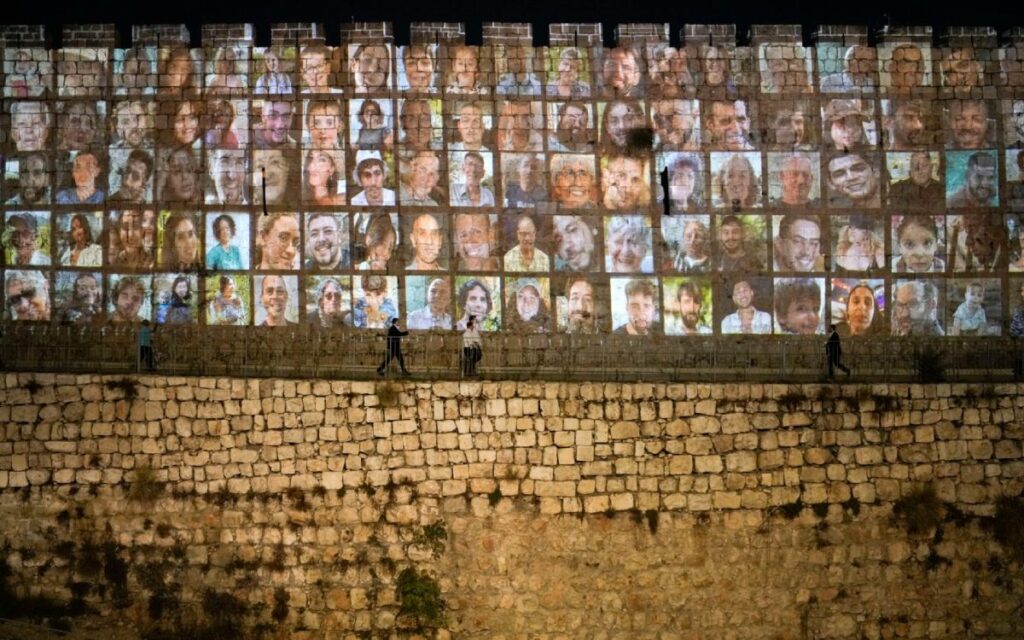
Photographs of Israeli hostages being held by Hamas militants are projected onto the walls of Jerusalem’s Old City on November 6. Photo Credit: Leo Correa/AP
Thanks to an interview with Charles C. Cooke conducted with Dan Senor last week, I have a greater and more complete understanding of why things have evolved in Gaza over the past several decades. I think my findings, thanks to Mssrs. Cooke and Senor are worth sharing.
Cooke’s podcast, an outgrowth of his work with National Review, often includes authors of recently released books or today’s newsmakers. An unabashed conservative, Cooke is also an atheist and self-described libertarian. Dan Senor, host of his own heavily trafficked podcast, Call Me Back, has been broadcasting his once-a-week show about three times a week since the Hamas terror attack on October 7, interviewing people close to the action, Israeli officials, and journalists covering the story closely and who have often been impacted personally. Full disclosure requires an admission. The views reflected in the interview or this article do not equate the attack on the Jewish people with Palestinian claims of persecution and torture. Any nation facing the kind of blitz that Israel faced on October 7 should have the latitude to respond as needed. With that clearly stated, allow me to provide a primer on what happened leading up to the Hamas assault just a day after the 50th anniversary of the start of the Yom Kippur War in 1973.
Senor selected a few key points to emphasize when presenting his summary. He boiled down the inflection points to 1967, 1987, 2005, and the most recent onslaught less than a month ago.
1967
Israel fought a defensive war in 1967 against Egypt, known as the Six-Day War. Israel captured the Gaza and Sinai land strips during this conflict. Also claimed were territories from Jordan and Syria, though this is less relevant. In 1979, as a condition of the peace treaties negotiated at Camp David, Israel agreed to return the Sinai Peninsula to Egypt, a land mass about three times the size of Israel. Egypt had little interest in Gaza, but returning the Sinai gained Israel three things from Egypt. First, Egypt would recognize Israel as an independent Jewish state. Secondly, they would accept Israel’s right to defend itself, and third, there would be diplomatic and commercial ties between the two nations. Even though about two million Palestinians were living in Gaza and Israel occupied the territory, Egypt showed little interest in taking back responsibility for the land and its inhabitants. The brewing desire for independence and sovereignty amongst the Palestinian people existed in the region, and it bubbled up in 1987.
1987
In 1987, an intifada (violent uprising) began that came in fits and starts over twenty years. The goal was to establish a Palestinian state that would create the same arrangements Egypt had worked out with Israel in 1979. For twenty years, attempts to create a Palestinian state out of the Gaza Strip and the West Bank occurred. Israel hoped to achieve a similar relationship with Palestine that it had with Egypt. Mutual recognition, two States living side-by-side and a stable peace. After many attempts to accomplish this, most of which ended in tears and violence, Hamas, a terrorist group founded in the 1980s, responded to the 1993 Oslo Accords. Prime Minister Yitzhak Rabin and Palestinian leader Yassir Arafat signed the Accords in September 1993, “affirming Israel’s right to exist.” In exchange for recognition of Israel and its citizens’ right to live in peace, the declaration of principles negotiated in Oslo centred on the process of establishing Palestinian self-governance in the West Bank and the Gaza Strip. The framework included many provisions. Implementation began in 1994. The religious extremists on both sides undermined progress, but in 1995 Oslo Two was negotiated, continuing the effort to establish the two states. Into the twenty-first century, Israel worked at getting this area settled. Every time they appeared to be making headway, Hamas upped the ante. They started sending suicide bombers into Jewish areas, killing many Israelis in random attacks. This pattern existed into the early 2000s. Israeli officials would be working hard to help the Palestinians create a separate state, only to have Hamas bomb Jewish civilians in a wanton round of senseless violence. The process would break down and eventually culminated in 2005.
2005
By this time, Ariel Sharon, a very controversial and right-wing leader, was Prime Minister of Israel. He expressed his exhaustion with the situation and decided to get out. He justified his decision because of the number of dead Israeli soldiers and the contentious relationship with the PLO. The cost had become too great and the reward too little. Israel pulled out and granted the Palestinians control of the land, with no negotiations and no territorial dispute. It is a valuable strip of land with lots of potential. It could have been developed into a tourist destination located on the Mediterranean. It owned capital and development money from the European Union. Staggering numbers. Billions and billions of dollars. All Israel wanted to do was get its people out. The government forcibly removed about a hundred families. They left their homes and greenhouses for the Palestinian people, taking only their belongings. The exit was so thorough they dug up some graves to remove relatives but otherwise voluntarily departed.
The Palestinians could have done anything with that land. The Palestinian Authority under Mahmoud Abbas controlled the territory but not the people. In what was essentially a civil war, the Palestinian people fought each other. Hamas, the fringe Islamist faction of the Muslim Brotherhood, staged a coup against Fatah, the existing government, in 2007. Hamas had won some seats in the Palestinian parliament, but Fatah, the more mainstream party, was still in charge. This coup was authentic, including the dropping of Fatah leaders from ten and twenty-storey buildings. With the leadership of Fatah slaughtered, Hamas took over Gaza, and Israel has had to live with these extremists on their border ever since. Hamas swears to the destruction of Israel and the elimination of the Jewish race.
They are not cute about this. They do not sugarcoat it, nuance it, or hide it. Anyone can read it in the charter. Israel tried to confront it in 2014 but lost a lot of soldiers and equipment. Flare-ups have occurred. Hamas would launch rockets, and Israel used the Iron Dome to protect itself. This happened repeatedly in 2008-09, 2014, and 2021. Gradually, Israel developed a Security Doctrine that allowed them to live with these threats and beat them back as they arose. That ended on October 7th when Hamas moved into Israeli territory and tried to execute in action what they had written on paper: the eradication of the Jewish people in the most barbaric way possible.
Thanks to Dan Senor, a former G. W. Bush official, we have a fulsome explanation of how we moved from the Six-Day War of 1967 to the present. The days, weeks, and months ahead will reveal how great a cost Hamas was willing to pay for hating the Jewish people more than they love their children.

Dave Redekop is a retired elementary resource teacher who now works part-time at the St. Catharines Courthouse as a Registrar. He has worked on political campaigns since high school and attended university in South Carolina for five years, where he earned a Master’s in American History with a specialization in Civil Rights. Dave loves reading biographies.




















